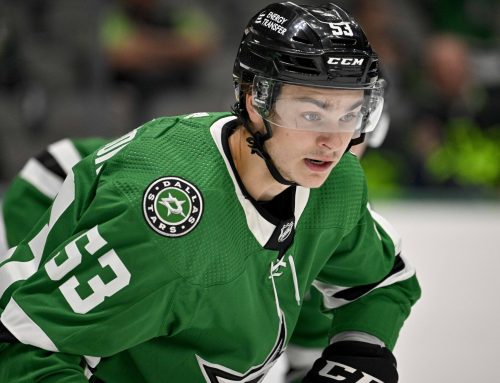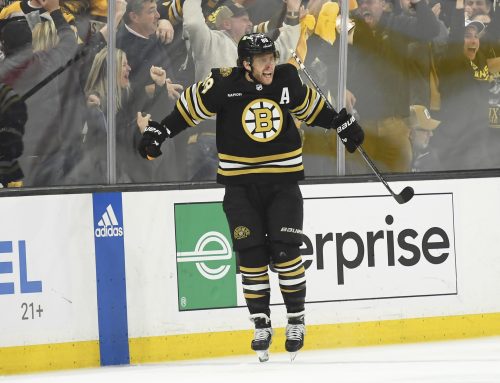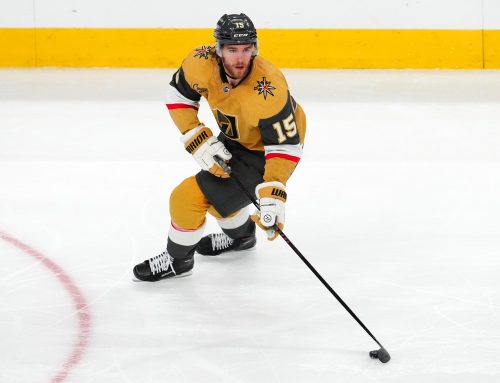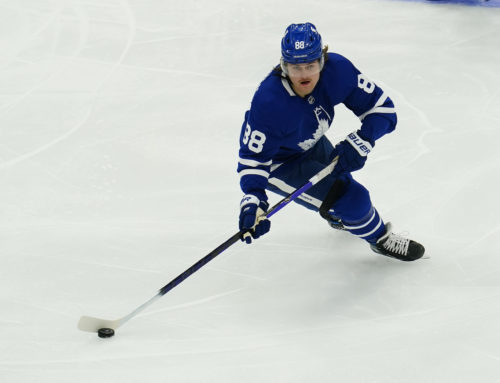Ramblings: Newhook’s Potential; Peripheral Stat Growth and Declines Based on Production Levels – July 13
Michael Clifford
2023-07-13
Alex Newhook signed a four-year deal with Montreal a couple of days ago, so the team is committed to making it work. He will have every opportunity to step into the team's top-6 forward mix and contribute offensively.
There was a good read from Arpon Basu over at the Athletic about why Newhook struggled in Colorado. In short, it was partly because of who he played with – the non-stars on the team – and how they asked them to play – dump-and-chase rather than off the rush. As Basu notes, Newhook is a player with a wealth of speed and playmaking talent. Asking that type of player to dump and chase is a mis-use of his talents. Montreal literally just went through this with Dominique Ducharme when he was still the coach and had Nick Suzuki and Cole Caufield doing the same. Martin St. Louis corrected that very quickly and they became a dynamic offensive duo.
Obviously, this is the hope for Newhook. Not only will he get better line mates – whether with Suzuki or with Kirby Dach – but he'll get line mates that like to play as he does. That will be reinforced by the coaching staff, too. I am a Habs fan that is still wary of the trade but there is a blueprint for success that Newhook will be able to follow. It's up to him now.
*
Leo Carlsson signed his ELC with the Anaheim Ducks so while it’s not confirmed, it sure looks like he’ll be in uniform come October.
The 2023-24 Ducks should be a lot more fun to watch. Add Carlsson, Zellweger, and any of their other top prospects, and it should make for exciting hockey.
*
My Ramblings on Tuesday looked at statistical changes in the NHL over the years, focusing on the last two in particular. We looked at rising goal and point rates, how that affected the scoring distribution, the rise (or fall) in peripheral stats, and how that impacts the peripheral distributions. Go check that out to get a feel for what we're talking about here.
Today's Ramblings will look at what it meant for individual players. Specifically, we're going to look at how players contributed across the various fantasy categories: goals, assists, shots, penalty minutes, hits, and blocks. Again, we'll be using Natural Stat Trick or Frozen Tools for our stats, unless otherwise indicated.
For this, we're going to look at the 2021-22 and 2022-23 seasons only. Because that 21-22 season still had some COVID protocols in place, we are going to focus on per-game production rather than just total production. There will be a games-played minimum, but it's not fair to compare a 22-23 season that had 116 players skate all 82 games to a 21-22 season that had just 45.
Let's start with goal-scoring.
In the 2022-23 season, there were 123 forwards that played 60 games and averaged a 20-goal pace over 82 games. The number of players to reach those marks in 2021-22 was 136. While it would seem the middle-class of goal scorers is disappearing, that isn't quite the case. This past season saw 195 players – forwards and defencemen – hit a 15-goal pace over 82 games. The number of players to hit that mark (and play 60 games) the year before was 194. The difference is there were a handful of defencemen that moved up, which reinforces something we've both discussed here at Dobber Hockey and seen with our own eyes: defencemen are getting more and more involved in the offence.
The Ramblings on Tuesday found that high-end goal scorers are more abundant than in recent memory, but it seems as if the third tier of goal scorers is shifting slightly to include more defencemen.
What about goals and peripherals? I thought a simple table would help illustrate the differences at various production levels from 2021-22 to 2022-23 (we are going to use the equivalent per-game paces for each stat mark and include only players that skated 60 games):
| Stat Marks | 2021-22 | 2022-23 |
| 20 goals, 200 shots, 100 hits | 20 | 20 |
| 30 goals, 200 shots, 100 hits | 10 | 13 |
| 15 goals, 164 shots, 82 hits | 61 | 55 |
| 15 goals, 150 shots, 70 hits | 89 | 80 |
| 10 goals, 20 assists, 164 shots, 82 blocks, 82 hits* | 4* | 10* |
| 10 goals, 164 shots, 100 blocks** | 18** | 15** |
| 25 goals, 164 shots, 82 PIM | 7 | 7 |
I want to discuss the two rows that have stars beside the stat marks.
The first starred row, with five different categories, saw more than double the players reach modest across-the-board totals. They were all defencemen in 2021-22 but only 9/10 were defencemen in 2022-23 as Columbus centre Boone Jenner joined the club. When we see so many more defencemen produce adequately across the board, it should be even more of an indicator of how much blue liners are getting involved in the play, one way or another.
As for the row with the double stars, I wanted to show how assists, shot blocking, and hits have changed. The Ramblings on Tuesday mentioned a rise in shot blocking but a fall in hits. That meant in 2021-22 there were 18 players that hit paced for 10 goals, 164 shots, and 100 blocks. However, in 2022-23, only 10 players reached paces of 10 goals, 164 shots, 20 assists, and 82 blocks and hits. When removing the assist component, that number is just 11. In other words, simply adding a respectable level of hits to the criteria drastically reduced the number of players who fit the criteria, even if we lowered the blocked shot threshold. Defencemen are doing more for both their own teams and fantasy owners alike, but the rise in blocks and drop in hits changes the mix of players that are sufficiently productive in each area.
Again, back in Tuesday's Ramblings, we saw that goal scoring went up by a total of 97 goals from 2021-22. Of those 97 extra goals, 39 of them came from defencemen. In other words, blue liners accounted for 40% of the rise in goals. Considering that rearguards scored 14.6% of the goals in 2022-23 but 14.3% the year before, this tracks.
Remaining on the blue line, if the position is changing so much, we should look to see what different levels of producers managed in 2022-23. So, between 2021-22 and 2022-23, what were the changes in peripheral stats for different levels of production? Again, we will be using equivalent 82-game paces and counting only players that skated at least 60 games:
| Stat | 2021-22 | 2022-23 |
| Hits/GP and Blocks/GP Among 30-Point Defencemen | 1.09 / 1.42 | 1.12 / 1.45 |
| Hits/GP and Blocks/GP Among 40-Point Defencemen | 1.05 / 1.43 | 1.14 / 1.44 |
| Hits/GP and Blocks/GP Among 50-Point Defencemen | 1.01 / 1.39 | 0.99 / 1.45 |
The first things that stood out to me were the hit rates. While there was a steady decline in hits at different point thresholds in 2021-22, there was a small rise between 30- and 40-point defencemen in 2022-23, followed by a crash by high-end producers. If that holds, it would make the high-end producers that actually lay the body – Rasmus Dahlin, Mikhail Sergachev – all the more important: out of eight defencemen that reached 70 points, only one managed at least 100 hits (Dahlin, 105).
The second thing that stood out to me where the consistent block rates in 2022-23. Regardless of point threshold, rearguards were blocking at roughly the same level. There was a significant rise in block rates across the league, and it appears to have affected the high-end producers more, bringing them on an even playing (blocking?) field with lesser producers. The big difference was in hit rates, so true multi-cat performers will carry extra value. Once again, Dahlin and Sergachev stand out here.
Keep in mind that "30-Point Defencemen" means everyone that reached that mark, including 70- and 80-point defencemen. The actual effects would be more extreme when removing players from the sample and focusing on, say, 25- to 35-point blue liners only.
Moving on to the forwards, let's look at different production/peripheral levels between the last two seasons:
| Stat | 2021-22 | 2022-23 |
| Shots/GP and Hits/GP Among 50-Point Forwards | 2.72 / 0.92 | 2.77 / 0.90 |
| Shots/GP and Hits/GP Among 70-Point Forwards | 3.08 / 0.89 | 3.10 / 0.82 |
| Shots/GP and Hits/GP Among 90-Point Forwards | 3.37 / 0.90 | 3.53 / 0.80 |
The surprising part here was how much shot rates increased from one year to the next. League-wide shot rates declined as players blocked more shots and teams focused more on quality. If the shot rates for these forwards increased, it tells us that the decline in shots came from either low-producing forwards or defencemen. In fact, shot rates for forwards under the 50-point threshold did fall from 1.62/game to 1.54.
This is also where the hit-rate drop across the league really comes into play. In 2021-22, the average 90-point forward put up 74 hits every 82 games. Last season, that hit total fell to 66. It may not seem like a lot but given that 90-point forwards are the ones always rostered in fantasy leagues, that means a decline of roughly 150 hits from elite producers. A drop of nearly 150 hits from 18 of the highest-owned players is a lot. It would make David Pastrnak's 91-hit season, and its repeatability, a very interesting proposition.
Just remember that these are averages among the players above a certain threshold. While the 90-point forwards averaged 3.5 shots and 0.8 hits per game, only one-third of them actually reached all three paces. How the stats are distributed among the players remains the puzzle to solve, and it's what makes fantasy hockey so much fun.
That is it for today. Tomorrow's Ramblings will dig into specific players.





 NYR
NYR CAR
CAR DAL
DAL VGK
VGK TOR
TOR STL
STL VAN
VAN BOS
BOS
